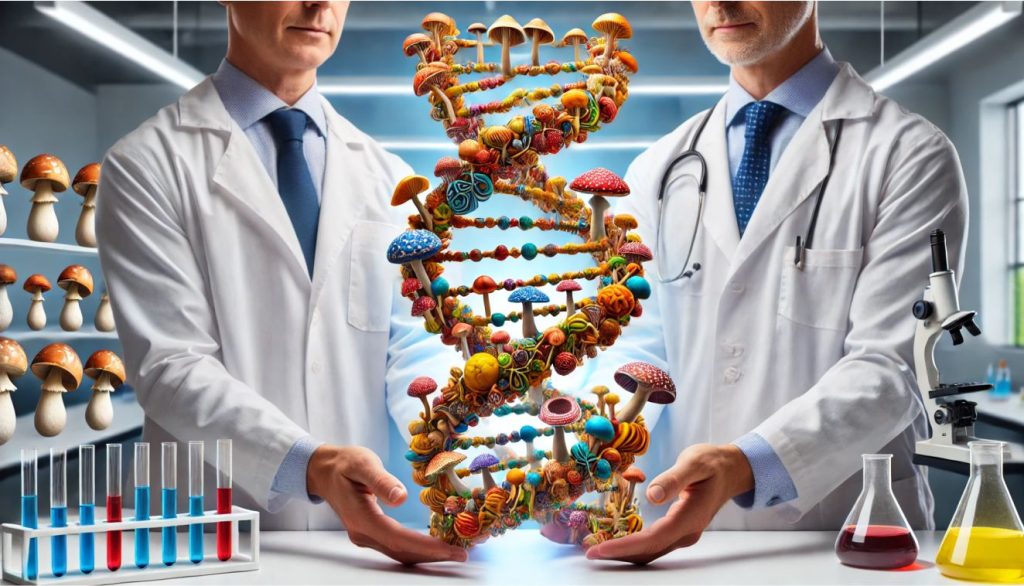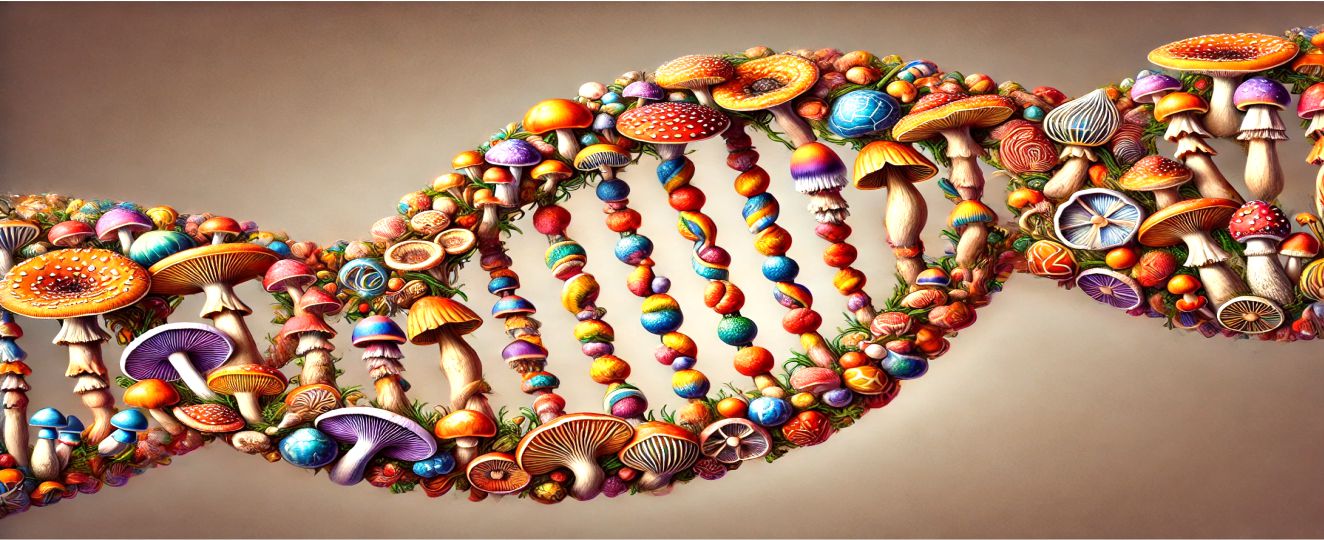Let’s be real, hallucinogenic drugs are a serious topic, and using them without knowing what you’re getting yourself into is a recipe for disaster.
Here’s the thing: magic mushrooms come in all shapes and sizes, with hundreds of known species. The “strains” have wildly different effects, ranging from a mild case of the giggles to a full-blown panic attack. The problem is that telling them apart may be tricky. Unlike that portobello you grab at the store, magic mushrooms often look pretty similar, and mistaken identity with a poisonous look-alike could be deadly. Yikes!
Strains of Magic Mushrooms: Different Species and their Molecular Structure
Even if you do manage to snag the “right” kind, there’s no guarantee of a smooth ride. Psilocybin, the hallucinogenic compound in hallucinogenic mushrooms such as Psilocybe, Panaeolus, Pluteus, and Gymnopilus, affects everyone differently. After ingestion, the hallucinogenic effects usually occur within 30 minutes and can last 4-6 hours.
Factors like your mood, mental health, and even the setting you’re in can all play a role in whether your trip is a blast or a total nightmare. Anxiety, paranoia, and even psychosis are all possible side effects, and let’s not forget the physical stuff like nausea, muscle weakness, and messed up blood pressure. Not exactly a relaxing day at the spa.
Popular Strains of Magic Mushrooms
Psilocybe Cubensis: The Popular Choice
Psilocybe Cubensis is the most widely recognized and cultivated strain of psilocybe mushrooms, known for their flesh that turns blue or green when bruised or cut. Often referred to as “shrooms,” this strain is popular due to its relatively easy cultivation process and consistent effects. The taxonomy and identification of psilocybe species involve understanding their molecular sequences, species relationships, and genetic markers. Psilocybe Cubensis mushrooms typically have a dark brown cap that turns golden brown with age. They are known for their moderate potency, making them a suitable choice for both beginners and experienced users.
Effects and Experiences
When user ingests Psilocybe Cubensis, the effects usually start within 30 minutes to an hour. The effects include:
- Visual and auditory hallucinations
- Enhanced colors and patterns
- Feelings of euphoria and connection
- Altered perception of time
While generally well-tolerated, some users may experience panic reactions or discomfort, particularly at higher doses.
Psilocybe Semilanceata: Liberty Caps
Psilocybe Semilanceata, or Liberty Caps, are small but potent magic mushrooms. They are typically found in subtropical regions and European countries. As one of the many mushroom species containing psilocybin and psilocin, they have a distinct conical cap and a slender stem, often making them easier to identify in the wild.
Potency and Hallucinogenic Effects
Liberty Caps are known for their high psilocybin content, which may lead to intense experiences even at lower doses. Users often report:
- Vivid visual hallucinations
- Deep introspection and philosophical thoughts
- Enhanced creativity and problem-solving abilities
However, the strong effects of Psilocybe Semilanceata could also lead to psychological consequences such as psychosis or anxiety disorders in some individuals.
Psilocybe Azurescens: The Heavyweight
Psilocybe Azurescens is one of the most potent psilocybin containing mushrooms. Native to the coastal regions of the Pacific Northwest, the mushrooms are characterized by their rusty brown caps and thick stems. Due to their high psilocybin content, Psilocybe Azurescens are recommended for experienced users.
Intense Experiences
The powerful effects of Psilocybe Azurescens include:
- Profound visual and auditory hallucinations
- Intense emotional experiences
- Deep mystical and spiritual insights
While the experiences could be rewarding, they also come with increased risks of panic reactions and other adverse effects, especially for those unprepared for such intensity.
Effects and Experiences
The effects of magic mushrooms vary greatly depending on the strain, dosage, and individual. Psilocybin, the primary hallucinogenic substance found in these mushrooms, is responsible for the visual distortions, enhanced colors, and patterns that users often experience. Additionally, users may feel a profound connection with nature and the universe.

Safety and Risks
While magic mushrooms provide profound and positive experiences, there are risks involved. Drug abuse, particularly involving hallucinogens, can lead to severe health issues and negative consequences. Panic reactions and psychosis are possible, especially with high doses or in individuals with underlying mental health disorders. Approach psilocybin use with caution and respect.
Identifying Magic Mushrooms
Identifying different strains of magic mushrooms gets tricky, as they often look similar to non-psychoactive or even poisonous mushrooms. Proper identification is needed to avoid the risks associated with consuming incorrectly identified mushrooms.
The Science Behind Psilocybin Containing Mushrooms
Psychoactive fungi, including those in the genus Psilocybe, Panaeolus, Pluteus, and Gymnopilus, are classified based on their taxonomy, phylogenetics, and ecology. Magic mushrooms belong to the genus Psilocybe, which encompasses numerous species known for their psychoactive properties. The primary compound responsible for the effects is psilocybin. When ingested orally, psilocybin is converted into psilocin, which interacts with the brain’s serotonin receptors.
The Role of Psilocybin
Psilocybin is the key ingredient in magic mushrooms. It is a naturally occurring compound that may also be produced synthetically. Research has shown that psilocybin has therapeutic potential, particularly in treating conditions like post-traumatic stress disorder (PTSD), anxiety disorders, and obsessive-compulsive disorder (OCD).
Legal Status
In many places, psilocybin mushrooms are classified as controlled substances under the Controlled Substances Act. It means their possession, sale, or use could be illegal. However, some regions are beginning to recognize their potential medical benefits and are decriminalizing or legalizing their use in certain contexts.
Safety and Identification
Correctly identifying magic mushrooms is necessary for safety. Mistaking a wild mushroom for a psychoactive one may lead to serious consequences, including possible death from ingesting poisonous mushrooms. When foraging for magic mushrooms, it’s essential to:
- Be familiar with the physical characteristics of the desired species
- Use reliable identification guides or apps
- When in doubt, consult an expert mycologist
The Role of Psilocybin in Therapy
Recent studies have shown promising results for the use of psilocybin in treating various mental health conditions. Research indicates that psilocybin therapy helps with:
- Post-traumatic stress disorder (PTSD)
- Obsessive-compulsive disorder (OCD)
- Anxiety disorders
- Depression
FAQs and Practical Insights on Magic Mushrooms
Do different strains of magic mushrooms have varying effects?
Absolutely. Magic mushrooms come in hundreds of strains, each with a unique genetic makeup and psilocybin content. That translates to a wide range of effects, from mild euphoria to intense hallucinations and even negative experiences like anxiety and paranoia.
How are magic mushroom strains identified and classified?
Identifying and classifying magic mushroom strains is a complex task that often requires microscopic analysis. Visual appearance alone is unreliable, as many species share similar characteristics. Scientists use factors like spore morphology, the presence of a veil or annulus (membranes on the mushroom), and even genetic sequencing to differentiate strains.
Can the appearance of a magic mushroom tell you its strain?
Unfortunately, no. While some experienced foragers may be able to make educated guesses based on subtle features, relying solely on appearance is dangerous. Many poisonous mushrooms closely resemble magic mushrooms, and mistaking one for the other may have serious consequences.
Are certain strains of magic mushrooms more potent than others?
Yes. The concentration of psilocybin, the hallucinogenic compound, varies between strains. Some, like Golden Tops, are known for their lower psilocybin content, while others, like Penis Envy, pack a much stronger punch.
What factors influence the potency of a magic mushroom?
Several factors influence the potency of a magic mushroom, including:
- Strain: As discussed earlier, different strains have varying psilocybin content.
- Growing conditions: Light, temperature, and humidity all affect psilocybin production.
- Harvesting time: Mushrooms psilocybin content changes as they mature.
- Storage: Improper storage degrades psilocybin over time.
The factors contribute to variations in psilocybin content, making it challenging to predict the exact effects of any given mushroom.
Are there any specific strains known for their visual distortions?
Yes. Some strains, like Penis Envy and certain varieties of Psilocybe cubensis, are known for producing intense visual hallucinations. They range from geometric patterns and distortions to vivid dream-like experiences.
Which magic mushroom strains might be better suited for beginners?
Due to the inherent risks and unpredictable nature of magic mushrooms, we strongly advise against using them, especially for beginners. There’s no such thing as a “safe” strain, and even low doses may trigger negative experiences. If you’re interested in exploring altered states of consciousness, there are safer and legal alternatives available.
Do different strains have varying risks of causing bad trips?
Yes. While all magic mushroom use carries some risk of a negative experience, certain strains with higher psilocybin content or those known to cause intense hallucinations may have a higher likelihood of inducing bad trips.
Is it safe to mix different magic mushroom strains in one trip?
No. Mixing different strains is strongly discouraged. The unpredictable nature of psilocybin and the variations between strains make it difficult to gauge the overall effect. It’s best to stick to a single strain, and even then, proceed with extreme caution.
Where would I find reliable information about specific magic mushroom strains?
Due to the legal status of psilocybin in most countries, reliable information about specific strains could be scarce. We recommend seeking information from scientific studies or reputable organizations focused on drug education.



